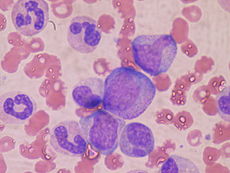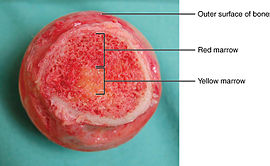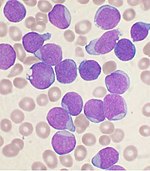develop your knowledge about bone marrow.
Bone marrow
Bone marrow is the flexible tissue in the interior of bones. In humans, red blood cells are produced by cores of bone marrow in the heads of long bones in a process known as hematopoiesis. On average, bone marrow constitutes 4% of the total body mass of humans; in an adult weighing 65 kilograms (143 lb), bone marrow typically accounts for approximately 2.6 kilograms (5.7 lb). The hematopoietic component of bone marrow produces approximately 500 billion blood cells per day, which use the bone marrow vasculature as a conduit to the body's systemic circulation. Bone marrow is also a key component of the lymphatic system, producing the lymphocytes that support the body's immune system.
Bone marrow transplants can be conducted to treat severe diseases of the bone marrow, including certain forms of cancer such as leukemia. Additionally, bone marrow stem cells have been successfully transformed into functional neural cells, and can also potentially be used to treat illnesses such as inflammatory bowel disease.
Structure
Types
The two types of bone marrow are "red marrow" (Latin: medulla ossium rubra), which consists mainly of hematopoietictissue, and "yellow jmarrow" (Latin:medulla ossium flava), which is mainly made up of fat cells. Red blood cells,platelets, and most white blood cells arise in red marrow. Both types of bone marrow contain numerous blood vessels and capillaries. At birth, all bone marrow is red. With age, more and more of it is converted to the yellow type; only around half of adult bone marrow is red. Red marrow is found mainly in the flat bones, such as the pelvis, sternum,cranium, ribs, vertebrae and scapulae, and in the cancellous ("spongy") material at the epiphyseal ends of long bones such as the femur and humerus. Yellow marrow is found in the medullary cavity, the hollow interior of the middle portion of long bones. In cases of severe blood loss, the body can convert yellow marrow back to red marrow to increase blood cell production.
Stroma
The stroma of the bone marrow is all tissue not directly involved in the marrow's primary function of hematopoiesis. Yellow bone marrow makes up the majority of bone marrow stroma, in addition to smaller concentrations of stromal cells located in the red bone marrow. Though not as active as parenchymal red marrow, stroma is indirectly involved in hematopoiesis, since it provides the hematopoietic microenvironment that facilitates hematopoiesis by the parenchymal cells. For instance, they generate colony stimulating factors, which have a significant effect onhematopoiesis. Cell types that constitute the bone marrow stroma include:
- fibroblasts (reticular connective tissue)
- macrophages, which contribute especially to red blood cell production, as they deliver iron for hemoglobinproduction.
- adipocytes (fat cells)
- osteoblasts (synthesize bone)
- osteoclasts (resorb bone)
- endothelial cells, which form thesinusoids. These derive fromendothelial stem cells, which are also present in the bone marrow.
Cellular components

Hematopoietic precursor cells:promyelocyte in the center, twometamyelocytes next to it and band cells from a bone marrow aspirate.
In addition, the bone marrow containshematopoietic stem cells, which give rise to the three classes of blood cells that are found in the circulation: white blood cells (leukocytes), red blood cells(erythrocytes), and platelets(thrombocytes).
Function
Mesenchymal stem cells
Main article: Mesenchymal stem cell
The bone marrow stroma containsmesenchymal stem cells (MSCs), also known as marrow stromal cells. These are multipotent stem cells that candifferentiate into a variety of cell types. MSCs have been shown to differentiate,in vitro or in vivo, into osteoblasts,chondrocytes, myocytes, adipocytesand beta-pancreatic islets cells.
Bone marrow barrier
The blood vessels of the bone marrow constitute a barrier, inhibiting immature blood cells from leaving the marrow. Only mature blood cells contain themembrane proteins, such as aquaporinand glycophorin, that are required to attach to and pass the blood vesselendothelium.Hematopoietic stem cells may also cross the bone marrow barrier, and may thus be harvested from blood.
Lymphatic role
The red bone marrow is a key element of the lymphatic system, being one of the primary lymphoid organs that generate lymphocytes from immature hematopoietic progenitor cells.The bone marrow and thymus constitute the primary lymphoid tissues involved in the production and early selection of lymphocytes. Furthermore, bone marrow performs a valve-like function to prevent the backflow of lymphatic fluid in the lymphatic system.
Compartmentalization
Biological compartmentalization is evident within the bone marrow, in that certain cell types tend to aggregate in specific areas. For instance,erythrocytes, macrophages, and theirprecursors tend to gather around blood vessels, while granulocytes gather at the borders of the bone marrow.
Clinical significance
Disease
The normal bone marrow architecture can be damaged or displaced byaplastic anemia, malignancies such asmultiple myeloma, or infections such astuberculosis, leading to a decrease in the production of blood cells and blood platelets. The bone marrow can also be affected by various forms of leukemia, which attacks its hematologic progenitor cells. Furthermore, exposure to radiation or chemotherapywill kill many of the rapidly dividing cells of the bone marrow, and will therefore result in a depressed immune system. Many of the symptoms of radiation poisoning are due to damage sustained by the bone marrow cells.
To diagnose diseases involving the bone marrow, a bone marrow aspirationis sometimes performed. This typically involves using a hollow needle to acquire a sample of red bone marrow from the crest of the ilium under general or local anesthesia.
Examination
Main article: Bone marrow examination
Bone marrow examination is the pathologic analysis of samples of bone marrow obtained via biopsy and bone marrow aspiration. Bone marrow examination is used in the diagnosis of a number of conditions, including leukemia, multiple myeloma, anemia, and pancytopenia. The bone marrow produces the cellular elements of the blood, including platelets, red blood cells and white blood cells. While much information can be gleaned by testing the blood itself (drawn from a vein byphlebotomy), it is sometimes necessary to examine the source of the blood cells in the bone marrow to obtain more information on hematopoiesis; this is the role of bone marrow aspiration and biopsy.
The ratio between myeloid series anderythroid cells is relevant to bone marrow function, and also to diseases of the bone marrow and peripheral blood, such as leukemia and anemia. The normal myeloid-to-erythroid ratio is around 3:1; this ratio may increase inmyelogenous leukemias, decrease inpolycythemias, and reverse in cases ofthalassemia.[10]
Donation and transplantation
Main article: Hematopoietic stem cell transplantation
In a bone marrow transplant, hematopoietic stem cells are removed from a person and infused into another person (allogenic) or into the same person at a later time (autologous). If the donor and recipient are compatible, these infused cells will then travel to the bone marrow and initiate blood cell production. Transplantation from one person to another is conducted for the treatment of severe bone marrow diseases, such as congenital defects, autoimmune diseases or malignancies. The patient's own marrow is first killed off with drugs or radiation, and then the new stem cells are introduced. Before radiation therapy or chemotherapy in cases of cancer, some of the patient's hematopoietic stem cells are sometimes harvested and later infused back when the therapy is finished to restore the immune system.
Bone marrow stem cells can be induced to become neural cells to treat neurological illnesses, and can also potentially be used for the treatment of other illnesses, such as inflammatory bowel disease. In 2013, following a clinical trial, scientists proposed that bone marrow transplantation could be used to treat HIV in conjunction withantiretroviral drugs; however, it was later found that HIV remained in the bodies of the test subjects.
Harvesting
The stem cells are typically harvested directly from the red marrow in the iliac crest, often under general anesthesia. The procedure is minimally invasive and does not require stitches afterwards. Depending on the donor's health and reaction to the procedure, the actual harvesting can be an outpatient procedure, or can require 1–2 days of recovery in the hospital.
Another option is to administer certain drugs that stimulate the release of stem cells from the bone marrow into circulating blood. An intravenouscatheter is inserted into the donor's arm, and the stem cells are then filtered out of the blood. This procedure is similar to that used in blood or platelet donation. In adults, bone marrow may also be taken from the sternum, while the tibia is often used when taking samples from infants. In newborns, stem cells may be retrieved from theumbilical cord.
Fossil record

Bone marrow may have first evolved inEusthenopteron, a species of prehistoric fish with close links to early tetrapods.
The earliest fossilised evidence of bone marrow was discovered in 2014 inEusthenopteron, a lobe-finned fish which lived during the Devonian period approximately 370 million years ago.Scientists from Uppsala University and the European Synchrotron Radiation Facility used X-ray synchrotron microtomography to study the fossilised interior of the skeleton'shumerus, finding organised tubular structures akin to modern vertebrate bone marrow. Eusthenopteron is closely related to the early tetrapods, which ultimately evolved into the land-dwelling mammals and lizards of the present day.




Comments
Post a Comment